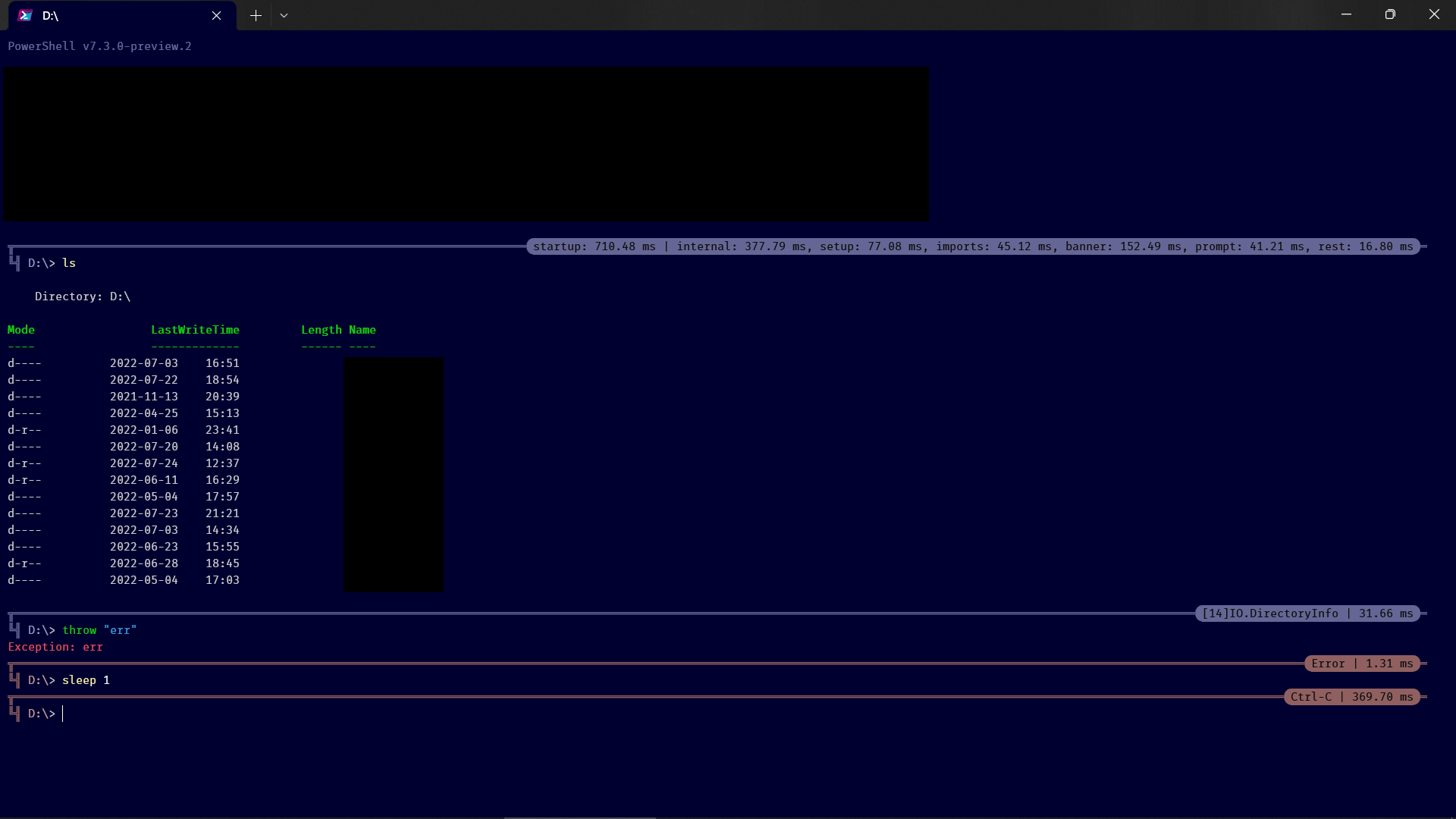My heavily customized Powershell 7 profile directory. Primarily developed for Windows, but my colleague also uses it on Linux and it seems to work. Currently requires at least PowerShell v7.3.0-preview.2.
# clone this repository and initialize submodules
$ConfigDir = Split-Path $PROFILE
git clone https://github.com/MatejKafka/powershell-profile $ConfigDir
cd $ConfigDir
git submodule update --init --recursive
# if you want more autocompletions, also install these modules
Install-Module PSGitCompletions
Install-Module WSLTabCompletion# clone this repository wherever you prefer
git clone https://github.com/MatejKafka/powershell-profile
cd powershell-profile
# initialize submodules
git submodule update --init --recursive
# symlink the main profile from $PROFILE (default profile file path)
New-Item -Type SymbolicLink $PROFILE -Target (Resolve-Path ./Microsoft.PowerShell_profile.ps1)
# if you want more autocompletions, also install these modules
Install-Module PSGitCompletions
Install-Module WSLTabCompletionIf you're not running in Windows Terminal, nothing will be loaded. I have it setup this way to make PowerShell load faster when invoked inside an IDE or from a script that does not specify the -noprofile PowerShell option. If you want to always load the profile, open .\Microsoft.PowerShell_profile.ps1 in a text editor and remove the if condition around the line where $PSScriptRoot\profile_full is imported.
This function is called in profile_full.psm1. Over time, I wrote multiple custom PowerShell modules that needed to store data somewhere (RSS feeds, TODO,...). To make this data directory configurable, all these modules get the data path from the custom PSDirectories module.
Root directory of the data path is configured by calling Set-PSDataRoot during the profile setup. I use the path $PSScriptRoot\..\data, which most probably doesn't make sense on any other setup than mine. :) A reasonable better choice might be:
- Windows:
$env:APPDATA\powershell-profile - Linux:
~/.local/share/powershell-profile
Note that as a safeguard, you must create the directory manually. This is the default so that the directory isn't accidentally created in the wrong (default) spot.
Modify the color scheme file PromptColorScheme.psd1 in the data directory (see the previous issue about Set-PSDataRoot to know where to look).
I'm a Windows guy, so I don't need Ctrl-d, and I'm using it to open FSNav (see below) instead. If you don't like that, change the key-binding in Prompt/FSNav.psm1.
Sorry, I spent quite a lot of time on optimizing it, but yeah, it's an order of magnitude slower than other shells, and quite a major part is the startup time of PowerShell itself, before my profile is even loaded. Hopefully the features will make it worth it for you.
Directory of custom modules, either written by me, or copied from the internet (source is noted in manifest file where applicable). For most of them, just read through the source (they're typically not large modules), few of the more interesting modules are described below:
-
PSLiveEdit – edit any loaded function and immediately reload it by calling
edit <function-name>(e.g.edit prompt) -
PSFileHandlers – a module which allows you to configure your preferred browser and terminal/GUI text editor, used by other modules when they need to open a website or a text file (
Open-Url,Open-TextFile) -
RSS – basic RSS reader; configure your RSS feed list by calling
rss-edit, then userssorrss-listto find what's new and read the articles -
Write-HostColor – Write-Host with full RGB colors in multiple formats
Modules which I once wrote (or copied), but I don't actively use them anymore, or they're under development and not working reasonably well yet. Some of them may work OK, other not so much.
Base profile script, loaded by PowerShell on startup. I have it symlinked from the default Documents\Powershell\Microsoft.PowerShell_profile.ps1 path. Checks if we're running in Windows Terminal (or Linux/MacOS), and imports the main profile module.
Main profile module, imported from the previous script. Sets sane defaults for error handling, sets up some data and module paths and imports other parts of the profile, most notably the custom prompt and custom functions.
Custom PowerShell prompt, showing last command run time, its return type (currently shows the first one, with item count prepended in case multiple values are returned) and return code (if the command did not finish correctly).
Also shows git status and python virtual environment (activate with Activate-Venv, indicator is then added to the prompt; deactivate as usual with deactivate).
Adds a Ctrl+d hotkey that allows you to navigate folders just by typing parts of the desired directory, similar to GUI file managers.
Also adds Ctrl+UpArrow, equivalent to cd ...
Many random useful functions that I use, but are not large enough to warrant a separate module. Read through it, maybe you'll find something useful for you. I'll highlight the notes function, which lets you add short notes that are shown at the top of each PowerShell session.
